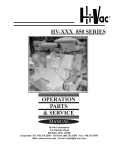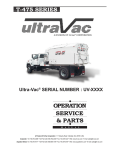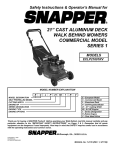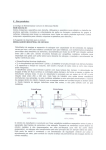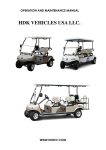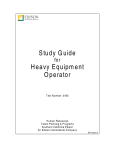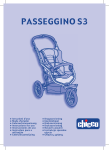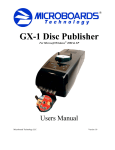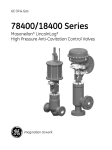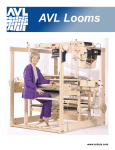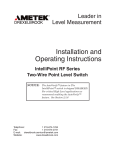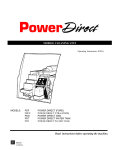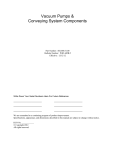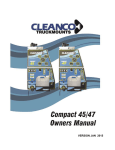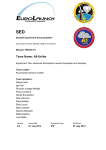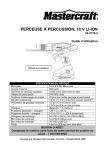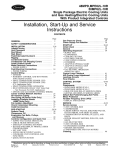Download OPERATION PARTS & SERVICE HV-XXX 250 - hi
Transcript
HV-XXX 250 SERIES OPERATION PARTS & SERVICE MANUAL Hi-Vac Corporation 117 Industry Road Marietta, Ohio 45750 Corporate: Tel: 740.374.2306 - Toll Free: 800.752.2400 - Fax: 740.374.5447 Web: www.hi-vac.com - E-mail: [email protected] TABLE OF CONTENTS INSPECTION OF YOUR NEW Hi-Vac® UNIT WARRANTY INFORMATION FOR YOUR NEW Hi-Vac® UNIT MESSAGE TO NEW OWNER SECTION 1 : SAFETY PRECAUTIONS GENERAL PRECAUTIONS AND WARNINGS PLEASE READ!! SAFETY FIRST!! SECTION 2 : MACHINE SPECIFICATIONS BASIC DESCRIPTION OF A Hi-Vac® UNIT THEORY OF OPERATION POWERHEAD HOPPER/STAND/TRAILER MACHINE COMPONENTS SHAKER ASSEMBLY SEAL ASSEMBLY FILTER BAG ASSEMBLY RECOMMENDED SPARE PARTS LIST SECTION 3 : OPTIONS AS LISTED SECTION 4 : INSTALLATION SET-UP PROCEDURES SECTION 5 : OPERATIONS PRESTART PROCEDURES START-UP PROCEDURES SHUTDOWN PROCEDURES AUTOMATIC PROTECTION SYSTEMS HEPA FILTER OPTION CONVEYING TIPS AND NOZZLE USAGE Hi-VAC® OPERATIONS, PARTS, & SERVICE MANUAL 2 SECTION 6 : MAINTENANCE BAG CHANGE PROCEDURES DUST PASSAGE FILTER CHANGING PROCEDURES TENSIONING V-BELT DRIVES ADJUSTING OIL LEVEL SWITCH ADJUSTING THE SENSITIVITY OF THE LEVEL PROBE MAINTENANCE INSTRUCTIONS RECOMMENDED LUBRICANTS LUBRICATION MAINTENANCE RECORD BILL OF MATERIALS SECTION 7 : PREVENTIVE MAINTENANCE DAILY CHECKS WEEKLY CHECKS MONTHLY CHECKS RECORDS TROUBLESHOOTING SECTION 8 : ELECTRICAL CONTROL PANEL SCHEMATIC SECTION 9 : ACCESSORIES ACCESSORIES SECTION 10 : MANUFACTURERS MANUALS ROOTS BLOWER MANUAL ENIDINE AIR BAGS DREXELBROOK LEVEL PROBE KUNKLE RELIEF VALVE LEESON ELECTRIC MOTORS FLANDERS HEPA FILTER GROVE GEAR REDUCER A/B MICRO 1000 (located on CD only) BARKSDALE VALVE DWYER INSTRUMENTS GEMS LEVEL SWITCH UNITED ELECTRIC CONTROLS Hi-VAC® OPERATIONS, PARTS, & SERVICE MANUAL 3 INSPECTION PROCEDURES All pieces received should be inspected for damage immediately upon receipt. 1. Damage can be most easily detected by looking for scrapes on the paint. 2. 3. 4. Inspect all sheet metal and structural steel for damage such as bends, kinks or breaks. 5. Check motor and vacuum pump for free rotation before starting under power for the first time after installation. 6. Compare the packing list attached to each piece of each shipment. 7. Verify the number of pieces and description of each piece shown on the packing slip. Check all wiring for abrasions, cuts, cracks, etc. If any are found, repair or replace before connecting to power source. Check all conduit runs and fittings for defects. REPORT ANY DAMAGE, NO MATTER HOW SLIGHT, IMMEDIATELY TO: Hi-Vac® Corporation 117 Industry Road Marietta, OH 45750 Attention: Service Department Phone: 740.374.2306 Toll Free: 800.752.2400 Fax: 740.374.5447 Storage of your Hi-Vac® unit Allow machine to be crated if at all possible while storing for short or long term durations. 1. For short-term storage. (30 days or less) A. 2. For storage over 30 days Rotate shafts every two to three weeks to avoid flat spotting of the ball bearings. A. To prevent damage due to corrosion, oxidation, etc., Refer to the maintenance manuals for each component. B. Make sure that the inlets to the piping manifold system are covered with the dust plugs to prevent foreign objects from entering the system. Add packages of desiccant to all electrical enclosures on sides of Hi-Vac®. C. D. Turn off the compressed air supply to the Hi-Vac® and relieve any pressure in the compressed air lines on the unit. Hi-VAC® OPERATIONS, PARTS, & SERVICE MANUAL 4 WARRANTY Hi-Vac® CORPORATION WARRANTS TO THE ORIGINAL PURCHASER OF THE Hi-Vac® UNIT QUOTED HEREIN THAT THE Hi-Vac® UNIT SHALL BE FREE FROM DEFECTS IN MATERIAL AND WORKMANSHIP UNDER NORMAL USE AND SERVICE. Hi-Vac® CORPORATION DOES NOT WARRANT COMMERCIAL ITEMS MANUFACTURED BY OTHERS SUCH AS DIESEL ENGINES, TRUCK CHASSIS, TIRES OR MOTORS. Hi-Vac® CORPORATION’S OBLIGATION UNDER THIS WARRANTY SHALL BE LIMITED TO THE REPAIR OR EXCHANGE OF ANY PART OR PARTS WHICH MAY PROVE DEFECTIVE UNDER NORMAL USE AND SERVICE WITHIN THE SHORTER PERIOD OF TWO (2) YEARS OR FOUR THOUSAND (4,000) WORK HOURS FROM THE DATE OF DELIVERY TO THE ORIGINAL PURCHASER AND WHICH Hi-Vac® CORPORATION’S EXAMINATION SHALL DISCLOSE TO ITS SATISFACTION TO BE DEFECTIVE. THIS WARRANTY REQUIRES PURCHASER TO OPERATE THE Hi-Vac® UNIT IN STRICT COMPLIANCE WITH THE PRINTED INSTRUCTIONS AND TO SERVICE THE Hi-Vac® UNIT ACCORDING TO THE METHODS AND SCHEDULES CONTAINED IN THE Hi-Vac® UNIT’S MANUAL. EVIDENCE OF PURCHASER’S SCHEDULED MAINTENANCE MUST BE REPORTED IN WRITING TO Hi-Vac® CORPORATION ON THE FORMS SUPPLIED TO PURCHASER IN THE Hi-Vac® MAINTENANCE MANUAL. SHOULD PURCHASER BELIEVE A DEFECT HAS BEEN DISCOVERED, THE PURCHASER SHALL RETURN THE ALLEGED DEFECTIVE PART TO Hi-Vac® CORPORATION FOR EXAMINATION, F.O.B THE Hi-Vac® PLANT, MARIETTA, OHIO. IN THE EVENT PURCHASER DOES NOT SERVICE AND MAINTAIN THE Hi-Vac® UNIT ACCORDING TO THE Hi-Vac® MAINTENANCE MANUAL, THE WARRANTY IS TO BE CONSIDERED NULL AND VOID AND Hi-Vac® CORPORATION’S OBLIGATION HEREUNDER SHALL BE DEEMED FULFILLED. THIS WARRANTY IS EXPRESSLY IN LIEU OF ALL OTHER WARRANTIES EXPRESSED OR IMPLIED, INCLUDING THE WARRANTIES OF MERCHANTABILITY AND FITNESS FOR USE AND OTHER OBLIGATIONS OR LIABILITIES ON THE PART OF Hi-Vac® CORPORATION. LIMITS OF LIABILITY Hi-Vac® CORPORATION SHALL NOT BE LIABLE FOR AND PURCHASER ASSUMES RESPONSIBILITY FOR ALL PERSONAL INJURY AND PROPERTY DAMAGE RESULTING FROM THE HANDLING, POSSESSION OR USE OF YOUR Hi-Vac® INDUSTRIAL VACUUM CLEANER BY THE PURCHASER. THE LIABILITY OF Hi-Vac® CORPORATION ARISING OUT OF THE SUPPLYING OF YOUR Hi-Vac® INDUSTRIAL VACUUM CLEANER, OR ITS USE WHETHER ON WARRANTIES OR CLAIM OF NEGLIGENCE OR OTHERWISE, SHALL NOT IN ANY CASE EXCEED THE COST OF CORRECTING DEFECTS IN YOUR Hi-Vac® INDUSTRIAL VACUUM CLEANER AS HEREIN PROVIDED. Hi-Vac® CORPORATION SHALL NOT IN ANY EVENT BE LIABLE FOR ANY LABOR EXPENDED BY THE PURCHASER ON ANY PART OR PARTS OR FOR ANY SPECIAL DIRECT OR INDIRECT OR CONSEQUENTIAL DAMAGES. NO MATERIAL MAY BE RETURNED WITHOUT FIRST GETTING APPROVAL FROM Hi-Vac® CORPORATION. ANY GOODS RETURNED WITH SUCH APPROVAL MUST BE SENT BACK WITH ALL TRANSPORTATION CHARGES PREPAID WITHIN 30 DAYS AFTER ISSUANCE OF APPROVAL. GOODS RETURNED AND ACCEPTED IN ACCORDANCE WITH THE ABOVE CONDITIONS WILL BE CREDITED ON THE BASIS OF THE PRICES PAID AT TIME OF SHIPMENT. Hi-VAC® OPERATIONS, PARTS, & SERVICE MANUAL 5 MESSAGE TO NEW OWNER Congratulations on your purchase of a new Hi-Vac® INDUSTRIAL VACUUM SYSTEM. Hi-Vac® Corporation is a leader in conveying and material pickup. The use of a Hi-Vac® system will not only save you money in the short term, it will also put you on the cutting edge of todays technology in vacuum systems. With HiVac’s vast array of configurations, it is possible to meet every consumers needs in material pickup for both wet and dry applications. To get the most out of your new Hi-Vac® INDUSTRIAL VACUUM SYSTEM , please read and review the contents of this manual and become familiar with the procedures within. Thank you for your purchase and we look forward to serving you again in the future. Hi-VAC® OPERATIONS, PARTS, & SERVICE MANUAL 6 SAFETY PRECAUTIONS SAFETY PRECAUTIONS CAUTION! SOME DO’S AND DON’TS BEFORE GETTING STARTED WITH YOUR NEW Hi-Vac® SYSTEM. The safety of the operator is of great importance to us at Hi-Vac® Corporation. The decals, shields, guards and other protective features that are designed into the machine are there for your protection. A high percentage of the accidents that occur are due to careless behavior or misuse of machinery. We ask you to be a careful operator and to properly service your machine. AIRLIFT SAFETY NOTE: Airlifts are standard on all units with an end dump hopper. Before startup, remove the three (3) powerhead shipping spacers and discard. This is done by unscrewing the pipe caps, slipping off the spacers, and reinstalling the three (3) caps on the pipe. BE SURE TO REINSTALL THE CAPS BACK ONTO THE PIPE. FAILURE TO DO SO MAY CAUSE SERIOUS INJURY TO PERSONNEL AND/OR DAMAGE TO MACHINE. Hi-VAC® OPERATIONS, PARTS, & SERVICE MANUAL SAFETY PRECAUTIONS 1 SAFETY PRECAUTIONS PROCEED WITH CAUTION! Before attempting to operate the machine, read carefully and understand all instructions contained in the manual. * Do not put your hand in front of the intake nozzle while in operation. * Do not put your face or any portion of head in front of the nozzle. * Do not open control panel or remove any junction box cover while main power supply is live. * Do not vacuum any flammable liquid. * For mobile configurations, check that unit is properly stopped so unit will not tip or roll. * Do not lubricate, adjust or repair the Hi-Vac® unit unless power source to the electric motor has been disengaged, and locked out. * Keep all safety devices in place, while operating your Hi-Vac® unit. * Read all warning and instruction decals placed on the machine and its associated equipment. * Allow only responsible, properly instructed individuals to operate the machine. * Always keep the Hi-Vac® unit in good operating condition. * * Clear the work area of objects that might interfere with proper operation of the Hi-Vac® unit. * Do not operate the Hi-Vac® unit while wearing loose clothing, watches or rings. * Periodically check for any loose bolts or set screws. Be careful to avoid overhead electrical installations. Extreme caution should be exercised whenever working near or around electrical installations. NOTE: AS WITH ANY TYPE OF HEAVY DUTY EQUIPMENT, CAUTION MUST BE EXERCISED IN ITS PROPER USE. CAUTION: KEEP HANDS CLEAR AND AWAY FROM BETWEEN POWERHEAD AND HOPPER WHEN POWERHEAD IS RAISED AND WHEN LOWERING POWERHEAD WARNING: FAILURE TO COMPLY WITH ANY OF THE ABOVE SAFETY INSTRUCTIONS OR THOSE THAT FOLLOW WITHIN THIS MANUAL MAY RESULT IN SEVERE INJURY OR DEATH! PLEASE REMEMBER: Safe operation begins with a safe operator. We ask you to be that type of operator. Hi-VAC® OPERATIONS, PARTS, & SERVICE MANUAL 2 SAFETY PRECAUTIONS MACHINE SPECIFICATIONS MACHINE SPECIFICATIONS BASIC DESCRIPTION OF A 200 SERIES Hi-Vac® UNIT. The MODEL NUMBER is broken down into three descriptive parts. 1. The first part is the SHELL SERIES. This describes the series of the Hi-Vac® unit. Both the LC and HC have twelve (12) filter bags. 2. The second part is the HORSEPOWER given to the POWERHEAD. There are six different ranges of motors on a 200 SERIES Hi-Vac®. 20HP, 25HP, 30HP, 40HP, 50HP, AND 75HP. 3. The third part is the clearance factor of the SHELL. The 200 SERIES Hi-Vac® has two different clearances depending on the application for which it is use. That being (HC) High Clearance or (LC) Low Clearance. The (LC) designation is always tagged onto the end of the model number. The (HC) designation is almost always assumed and usually left off. Hi-VAC® OPERATIONS, PARTS, & SERVICE MANUAL MACHINE SPECIFICATIONS 1 MACHINE SPECIFICATIONS THEORY OF OPERATIONS A SIMPLE NARRATIVE OF HOW A Hi-Vac® WORKS The following pages will describe, in as much detail as practical, the Hi-Vac® vacuum system. The system consists of four major components. The Hi-Vac® Powerhead, which is the actual vacuum producing part of the system, is mounted on a hopper. The Powerhead and hopper are mounted in a support stand. Connected to the Powerhead/hopper/support stand assembly is a pipe (hose), used to direct vacuum (air flow to material to be conveyed). The intent of the system is to pick up spills and dust accumulations through various parts of the Hi-Vac® and return the materials to the to the plant. By carefully reading and following the instructions contained herein, the equipment will operate reliably and the plant environment will be improved, thereby making it a safer and cleaner place to work. The Hi-Vac®, in it’s simplest form, is a large vacuum cleaner. A positive displacement pump is used to evacuate the air from the storage bin below the Hi-Vac® Powerhead. Because there is a vacuum in the hopper, air enters it through the pick-up hose and piping connected to the unit. It is this air movement that conveys the material from the pick-up point to the Hi-Vac®. The heart of the system is a positive displacement lobe vacuum pump (blower). It is driven by a coupler or a set of v-belts and sheaves connected to a drive element, which could be an electric motor or a fuel fed engine. The blower contains impeller lobes spinning in opposite directions and always in contact of each other and the blower housing. While spinning, the lobes are capturing small volumes of air and pushing them out of the blower discharge and through an exhaust silencer back into the atmosphere. In order to prevent the material (and the dust generated by this conveying procedure) from being discharged into the atmosphere as well, a set of filter cartridges are installed. Before the air and material go into the blower they must first pass through these cartridges which remove nearly 100% of the dust from the air. As well as protecting the atmosphere from dust, this also stops any dust from entering the blower and causing serious damage. There is one stage of separation of the material and dust from the air before they get to the filter cartridges. As the material enters the Hi-Vac® from the pickup hose and piping system it goes through a centrifugal separator which spins the material out of the air stream and into the collection bin below the Powerhead. Any material left in the air is then carried to the filter bags. As the air passes through the filter cartridges, the dust is trapped on the outside of the cartridges. Every 10 to 15 seconds, compressed air is blasted into the inside of the cartridges. This pulse of air keeps the outside of the cartridges clean. There are several different types of material bins, all of which will eventually fill with material. When this occurs, the unit will shut down and cannot be restarted until this condition is corrected. In some cases, as with end dump and rear dump hoppers, the Powerhead will be lifted off of the hopper with an airlift. The hopper will then be taken by a fork lift to a location to be emptied then replaced below the Powerhead. In this case the Powerhead must be restarted manually. In other cases, as with bottom dump hoppers, it may have a self dumping discharge gate. In this situation, the unit will shut down momentarily, discharge the material, the gate will close, and the unit will restart automatically (there is a switch in the panel to override this auto-restart). This self dumping gate may be replaced with any one of several optional discharges. Any thing from rotary feeders and pinch valves (for continuous discharge) to knife gates and fluid powered swing gates (for regulated and/or remote applications). Hi-VAC® OPERATIONS, PARTS, & SERVICE MANUAL 2 MACHINE SPECIFICATIONS MACHINE SPECIFICATIONS 3 4 6 1 5 2 7 POWERHEAD ITEM 1 2 PART # DESCRIPTION 09-0002-MFD SILENCER,5”,STANDARD HI-VAC 20-0216 HEPA FILTER,24x24x11-1/2,SS,HT,HI-CAP. (Inside Plenum) 1 1 3 4 16-0006 03-0392 VALVE,VACUUM RELIEF,3”,(18”HG) BLOWER,ROOTS,412 RAMJ,WHISPAIR,RH,BD 1 1 5 04-0003 MOTOR,50HP,230/460/3/60,326T,TEFC 1 6 27-0181 DREXELBROOK POINT-LINE LEVEL PROBE SYSTEM 1 7 27-0012 SWITCH,OIL LEVEL,SPST N/O 2 Hi-VAC® OPERATIONS, PARTS, & SERVICE MANUAL 3 QTY MACHINE SPECIFICATIONS MACHINE SPECIFICATIONS 1 2 4 3 HOPPER/STAND ITEM PART # 1 2 3 15-0001 VALVE,4-WAY,1/4NPT,MANUAL,AIR LIFT 15-0066 BAG,AIR LIFT,DOUBLE CONVOLUTE 31-2022-MFD STAND,A/L,2CU.YD.,200/400/800 SERIES 4 30-1005-MFD HOPPER,END,1.5YD Hi-VAC® OPERATIONS, PARTS, & SERVICE MANUAL 4 DESCRIPTION MACHINE SPECIFICATIONS QTY 1 4 1 1 510 512 506 523 519 502 517 513 521 516 518 508 515 514 505 520 522 303 305 304 509 301 501 527 526 521 701 507 525 504 503 302 103 105 601 602 103 102 704-10 704-11 101 103 104 201 204 703 702-2 702-3 702-4 702-1 206 207 202 703 704-1 MACHINE SPECIFICATIONS MACHINE COMPONENTS (page 1 of 3) Hi-VAC® OPERATIONS, PARTS, & SERVICE MANUAL MACHINE SPECIFICATIONS 5 MACHINE SPECIFICATIONS MACHINE COMPONENTS (page 2 of 3) ITEM PART # DESCRIPTION 101 102 01-2203-MFD SHELL WELDMENT,200 SERIES HIGH CLEARANCE 01-2209-MFD DOOR,SIDE BAGHOUSE,200 SERIES 103 104 18-0188 GASKET,RUBBER UTILITY,1/4” X 3/4” X 50’ 01-2208-MFD DOOR,TOP BAGHOUSE,200 SERIES 1 1 105 01-2212-MFD DOOR,LINEAR SEPARATOR,200/400 SERIES 1 1 1 201 20-0027 FILTER BAG,HC,POLYESTER FELT 12 202 19-0008 CAGE,FILTER BAG,HIGH CLEARANCE UNITS 12 204 206 207 01-1386-MFD BAR,RETAINER,END,HI-VAC BAGS,200 SERIES 08-0007 PIN,COTTER,1/8” X 1”,PLTD,HAMMERLOCK 01-1387-MFD BAR,RETAINER,MIDDLE,HI-VAC BAGS,200 SERIES 2 4 7 301 04-0003 MOTOR,50HP,230/460/3/60,326T,TEFC 1 302 04-0068 MOTOR SLIDE BASE,326T FRAME 1 303 01-2927-MFD ISOLATOR BASE,200/400 SERIES 1 304 18-0260 ISOLATOR,SMALL 8 305 18-0209 ISOLATOR,MEDIUM 8 501 03-0392 BLOWER,ROOTS,412 RAMJ,WHISPAIR,RH,BD 1 502 09-0002-MFD SILENCER,5”,STANDARD HI-VAC 1 503 11-0185-MFD NOZZLE,LINEAR SEPARATOR,50HP 1 504 11-0189-MFD ORIFICE PLATE,50HP 1 505 02-3497-MFD INLET PIPING,R412,200 SERIES 1 506 02-0147-MFD DISCHARGE PIPING,R412-J,200/400 SERIES 1 507 12-0030-MFD BROKEN BAG DET,240/250HC,608 1 508 509 09-0007 RAINCAP,5.25”,ALUM,#18 01-5173-MFD BLOWER BASE,R412,250 HIVAC Hi-VAC® OPERATIONS, PARTS, & SERVICE MANUAL 6 QTY MACHINE SPECIFICATIONS 1 1 MACHINE SPECIFICATIONS MACHINE COMPONENTS (page 3 of 3) ITEM PART # DESCRIPTION LUBE LEVEL SWITCH ASSY,R-409,412,418 VALVE,VACUUM RELIEF,3”,(18”HG) MUFFLER ISOLATION BRACKET,200HC/400HC QTY 510 512 513 27-0026-MFD 16-0006 09-0054-MFD 1 1 1 514 06-0153 SHEAVE,5V15.0 X 4-E 1 515 06-0132 BUSHING,E X 2.125 1 516 06-0137 SHEAVE,5V7.1 X 4-SF 1 517 U3403-0017 BUSHING,SF X 1.5 W/ 3/8 KW QD SERIES 1 518 07-0007 BELT,5VX1060 3 519 520 01-1888-MFD 01-5174-MFD FLANGE,MUFFLER,5”,200/400 SERIES BELT GUARD BACK,250HC,R412 1 1 521 01-5175-MFD BELT GUARD COVER,250HC,R412 1 522 01-5176L-MFD BRACKET,LEFT,BELTGUARD,250HC,R412 1 523 18-0146 GASKET,FLANGE,5”,FOR USE W/5”DIA EXHAUST 2 525 18-0003 GASKET,1/4” X 2” X 50’ ROLL 526 18-0423 SLEEVE,FLEXIBLE,6”ID X 4-PLY X 6” LONG 2 527 10-0575 CLAMP,T-BOLT,6-1/4” - 6-9/16”,HEADR SLVE 2 601 18-0042 GASKET,INLET 1 602 01-0875-MFD INLET ADAPTER,5”,200 SERIES 1 701 27-0181 DREXELBROOK POINT-LINE LEVEL PROBE SYSTM 1 702-1 16-0011 GAUGE,VACUUM,0-30”,5 1/4 DIA FACE 1 702-2 02-0256 ELBOW,PIPE,90D,1/4”FNPT,150#,MI 1 702-3 02-0048 ADAPTER,STR,1/4”MNPT X 1/4” HOSE BARB 2 702-4 10-0041 HOSE,FUEL LINE,PUSH-LOC,1/4” 8 704 12-0046 INSTALLATION,MAGNEHELIC(PRESS.DIFF)GAUGE 1 .0700 Hi-VAC® OPERATIONS, PARTS, & SERVICE MANUAL MACHINE SPECIFICATIONS 7 MACHINE SPECIFICATIONS SHAKER ASSEMBLY (page 1 of 2) 203-4 203-5 203-6 203-1 203-2 112 203-6 403 110 203-3 103 402 413 407 415 406 414 416 408 404 314 405 ITEM 103 110 112 203-1 PART # DESCRIPTION GASKET,RUBBER UTILITY,1/4” X 3/4” X 50’ 01-2211-MFD DOOR,SHAKER COVER,200 SERIES 18-0188 01-2525-MFD RAINSHIELD,SHAKER MOTOR,200/300/400 01-1923-MFD BAR,TIE,200 SERIES 203-2 18-0292 203-3 A107216 203-4 A107062 203-5 21-0905 203-6 A107214 314 04-0102 BUMPER,RECESS SCREW,CAP,5/16-18 X 1”,HH,PLT,GR8 NUT,HEX,5/16”-18,GR8,PLATED LOCK WASHER,RCS BUMPER*NO LONGER USED WASHER,FLAT,5/16” SAE,PLATED,GR8 MOTOR,3/4HP,230/460/3/60,56C,TEFC Hi-VAC® OPERATIONS, PARTS, & SERVICE MANUAL 8 401 MACHINE SPECIFICATIONS QTY 1 1 1 1 1 1 1 2 1 1 MACHINE SPECIFICATIONS SHAKER ASSEMBLY (page 2 of 2) ITEM PART # DESCRIPTION QTY 401 01-1168-MFD MOUNT,SHAKER GEAR,200/300/400 SERIES 402 01-2514-MFD SHAKER SHAFT,200 SERIES 1 403 01-2515-MFD DRIVE BAR,SHAKER,200 SERIES 24-0059 BAG SHAKER,ECCENTRIC 1 404 405 25-0013 406 17-0010 407 08-0009 408 21-2405 413 08-0068 414 08-0136 415 18-0056 GEAR REDUCER,SHAKER BEARING,3/8” ROD END YOKE END,3/8”-24,W/CLEVIS PIN & COTTER SCREW,SET,5/16”-18 X 3/4”,SOCKET PIN,CLEVIS,1/2” DIA. X 2” LONG PIN,COTTER,1/8” X 2” GASKET,RUBBER DIAPHRAGM 1 1 1 1 1 2 1 1 1 Hi-VAC® OPERATIONS, PARTS, & SERVICE MANUAL MACHINE SPECIFICATIONS 9 MACHINE SPECIFICATIONS SEAL ASSEMBLY 606 605 607 101-31 101-31 109 108 107 106 ITEM PART # 101-32 18-0026 106 18-0041 107 01-0873-MFD 108 18-0040 109 01-0869-MFD 605 01-2223-MFD 606 01-2224-MFD 607 01-2225-MFD 101-31 18-0027 DESCRIPTION GASKET,SHORT,1”x6”x45 1/4”LG.NEOPRENE GASKET,LONG,1”x6”x61 1/2”LG.NEOPRENE SEAL,FLAP,BAGHOUSE BAR,RETAINER,BAGHOUSE FLAPSEAL SEAL,FLAP,LINEAR SEPARATOR BAR,RETAINER,LINEAR SEPERATOR FLAPSEAL CENTRIFUGAL RING,200 SERIES,STD INLET PIPE,200 SERIES STACK EXTENSION,200 SERIES Hi-VAC® OPERATIONS, PARTS, & SERVICE MANUAL 10 MACHINE SPECIFICATIONS QTY 2 2 1 1 1 1 1 1 1 MACHINE SPECIFICATIONS FILTER BAG ASSEMBLY 207 204 204 210 211 212 213 214 208 213 214 208 201 202 203 209 209 205 ITEM 201 202 203 204 PART # 20-0027 19-0008 206 DESCRIPTION FILTER BAG,HC,POLYESTER FELT CAGE,FILTER BAG,HIGH CLEARANCE UNITS 20-0076-MFD KNOCKER BAR ASSY,200HC,12 BAG 01-1386-MFD BAR,RETAINER,END,HI-VAC BAGS,200 SERIES QTY 12 12 1 2 205 21-1106 WASHER,FLAT,3/8” NOM,GR5,PLATED 4 206 08-0007 PIN,COTTER,1/8” X 1”,PLTD,HAMMERLOCK 4 207 01-1387-MFD BAR,RETAINER,MIDDLE,HI-VAC BAGS,200 SERIES 7 208 21-1406 BOLT,3/8”-16 HEX x 2-1/2”LG, GR 5, PLATE 38 209 18-0126 GROMMET,5/16”I.D. 36 210 21-1404 BOLT,1/4”-20 HEX 14 211 A107214 WASHER,FLAT,5/16” SAE,PLATED,GR8 14 212 21-0904 WASHER,LOCK,1/4”NOM,GR8,PLATED 14 213 21-1106 WASHER,FLAT,3/8” NOM,GR5,PLATED 38 214 A107294 WASHER,LOCK,3/8”,PLT,GR8 38 Hi-VAC® OPERATIONS, PARTS, & SERVICE MANUAL MACHINE SPECIFICATIONS 11 MACHINE SPECIFICATIONS RECOMMENDED SPARE PARTS LIST ITEM PART # 20-0027 19-0008 FILTER BAG,HC,POLYESTER FELT CAGE,FILTER BAG,HIGH CLEARANCE UNITS 2 18-0040 SEAL,FLAP,LINEAR SEPARATOR 1 3 4 18-0041 16-0011 SEAL,FLAP,BAGHOUSE GAUGE,VACUUM,0-30”,5 1/4 DIA FACE 1 1 5 16-0012 GAUGE,DIFF PRESSURE,0-20”,4 3/4 DIA FACE 1 6 13-0001 SWITCH,PRESS. DIFF,SPDT,3-22”WC 1 7 20-0069 FILTER TUBE,PRESSURE DIFFERENTIAL 4 8 18-0188 GASKET,RUBBER UTILITY,1/4” X 3/4” X 50’ 1 9 20-0073 FILTER ELEMENT,FOR BROKEN BAG DETECTOR 3 10 17-0010 BEARING,3/8” ROD END 1 11 24-0059 BAG SHAKER,ECCENTRIC 1 12 08-0009 YOKE END,3/8”-24,W/CLEVIS PIN & COTTER 1 13 18-0056 GASKET,RUBBER DIAPHRAGM 2 14 20-0216 HEPA FILTER,24x24x11-1/2,SS,HT,HI-CAP. 1 1 2 DESCRIPTION Hi-VAC® OPERATIONS, PARTS, & SERVICE MANUAL 12 MACHINE SPECIFICATIONS QTY 12 12 OPTIONS OPTION 110 END DUMP RESTART OPTION 440 STARTER,1/4HP MOTOR OPTION 621 HEPA FILTER DIFFERENTIAL SHUTDOWN INSTALLATION INSTALLATION SET-UP PROCEDURES After you have done all the inspection procedures as recommended in the beginning of this manual, you are now ready to install your Hi-Vac® unit. Please follow the procedures listed in this section. If you have any questions, please feel free to call Hi-Vac® at 1.800.752.2400 or in OHIO call 1.740.374.2306. Your Hi-Vac® unit is broken down into 4 sections. Hopper, Stand, Airlift, and Powerhead. Once together, you can move the unit throughout the plant using the optional 4 wheeled In-Plant trailer. Be sure that the Airlift is bolted to the stand before operation begins. A C B Note: When moving the Powerhead and/or Hopper, always lift from the fork openings. Note: Refer to your electrical schematic for proper voltage specification. Note: Use National or Local electrical codes to install incoming power to your Hi-Vac® unit. 1. Connect customer supplied power cord as shown in item A. This must be done by a certified electrician. 2. Connect Airline to unit as shown in item B. The minimum required air pressure is 1 CFM at 90 PSI. Caution: Maximum air pressure should not exceed 120psi. 3. Remove the three (3) spacers on powerhead guides. Be sure to replace caps on guides and tighten down firmly. See item C. 4. You are now ready for the Pre-start procedures for your new Hi-Vac® unit. Hi-VAC® OPERATIONS, PARTS, & SERVICE MANUAL INSTALLATION 1 OPERATIONS OPERATIONS PRESTART PROCEDURES Note: As with any type of heavy duty equipment, caution must be exercised in its proper use. A thorough understanding of the use and functions of this equipment should be attained before an attempt is made to use it. 1. Connect or disconnect vacuum conveying hoses and fittings to the machine inlet pipe or manifold system only when the powerhead is off. Note: FAILURE TO DO SO COULD RESULT IN INJURY TO OPERATING PERSONNEL. 2. Before starting the machine, check all fluid levels. This includes the vacuum pump oil levels (Rear on all units and shaft end if so equipped). Level should be midway on site glass. TYPES OF OIL SITE GLASSES 3. Before starting the machine, check all wiring for abrasions, cuts, cracks, etc. If any, repair or replace. Note: BE SURE TO DISCONNECT ALL POWER WHEN REPAIRING ELECTRICAL LINES. FAILURE TO DO SO COULD RESULT IN INJURY. 4. Before starting the machine, check all conduit runs and fittings for defects. Hi-VAC® OPERATIONS, PARTS, & SERVICE MANUAL OPERATIONS 1 OPERATIONS PRESTART PROCEDURES Control Power 5. Check electric blower motor for proper rotation as follows: 1. Pull the “Control Power” switch to the on position. 2. Place hand under HEPA Filter plenum. 3. “Bump” electric motor by pushing the “Blower Start” button and immediately push the “Blower Stop/Reset” button. Blower Start Blower Stop/Reset I. If air is exhausted from the plenum, the rotation is correct. II. If air is pulled into the plenum, the rotation is wrong. a. Correct this by first insuring that incoming power is disconnected, then rewire incoming service wire at the top of the circuit breaker. Note: This will correct both the blower motor as well as the bag shaker motor. DO NOT REVERSE ANY WIRES BELOW THE CIRCUIT BREAKER. 6. HEPA Filter Plenum Check bag shaker timer setting as follows: A. Initiate a bag shaking cycle by “bumping” the blower motor as stated for the motor rotation. B. Note: Verify that the shaker motor runs for at least 30 seconds. If not, adjust timer located inside main electrical control panel under the programmable controller. Additional shaking time is required to higher dust loads. Maximum shaking time is 60 seconds. Bag Shaker Motor Hi-VAC® OPERATIONS, PARTS, & SERVICE MANUAL 2 OPERATIONS OPERATIONS START-UP PROCEDURES A. Electric Motor Drive 1. 2. Perform pre-start procedures Confirm that vacuum conveying hoses and fittings are connected and pick up nozzle is out of material so that the vacuum pump may “breathe freely” during startup. Note: Always connect or disconnect vacuum conveying hoses and nozzles to your Hi-Vac® inlet or manifold before turning on the powerhead. FAILURE TO DO SO COULD RESULT IN INJURY TO OPERATING PERSONNEL. 3. Control panel door must be closed and locked. 4. Circuit breaker turned on. 5. “Control Power” turned on by pulling out on button. 6. Push blower “Stop/Reset” button. 7. Push blower “Start” button. Note: Note: For units supplied with the new Drexelbrook “The Point Series” Level Probe: During initial start-up and after a loss of power, the operator must wait approx. 20 seconds to allow the probe to finish its calibration cycle. The blower will not start and the “Hopper Full” light will remain on until the cycle is complete and the blower “Stop/Reset” button is pushed. Control Power Blower Start Blower Stop/Reset The blower is turning in the correct rotation if the silencer exhaust cover lifts open and air is discharging from the silencer. 8. Your Hi-Vac® is now operating and ready to use. Check your gauges to make sure tha the unit is running correctly. 9. Slowly introduce the pickup nozzle into the material to be conveyed. Hi-VAC® OPERATIONS, PARTS, & SERVICE MANUAL OPERATIONS 3 OPERATIONS SHUTDOWN PROCEDURES A. Manual Stopping 1. Remove vacuum hose intake nozzle from material and allow sufficient time for vacuum hose to clear itself. 2. 3. When time permits, allow vacuum pump to continue to run with no load “free breathing” until vacuum pump temperature drops below 240 Deg. F as shown on “Temperature Gauge” located on right side of control panel. Push blower “Stop/Reset” button. Note: When vacuum pump stops spinning and there is zero air flow, the bags will automatically be shaken.Wait for the bag shaking system to complete its cycle before either restarting the blower, or turning off the control panel power. 4. Push in “Control Power” button. Note: Never stop powerhead with “Control Power” button. Always go through the above described stopping sequence. Hi-VAC® OPERATIONS, PARTS, & SERVICE MANUAL 4 Control Power OPERATIONS Blower Start Blower Stop/Reset OPERATIONS SHUTDOWN PROCEDURES B. Emergency Automatic Stopping An LED on the Programmable Logic Controller (located in the control panel), will light if any of the Safety Faults shut down the unit. Please refer to the following LED’s to find out why the unit has shut down. 1. INPUTS The control panel is now ready, for any control signals that it receives Input “I/1” and “I/2 are prewired from the two timers that are located just beside the controller. These two timers adjust the bag shake time and the automatic restart time if a self dumping hopper is used. Shaker Timer Restart Timer Programmable Logic Controller a. The following inputs are “Blower Shutdown” signals: I / 4 Broken Filter Material has passed through the filters and the broken bag detector has sensed it. Check filters immediately. Replace any filters that are torn. Make sure that all filters are being held tightly in place and that the dust cannot be allowed to pass around the filters. I / 7 Blower Stop/Reset button This button stops the blower. It is also used to reset a fault. I / 8 End Dump Hopper Full The end dump hopper is full. Empty hopper. I / 9 Low Blower Oil The level of the oil in the blower is too low. Check the level of the oil in the blower. Fill with oil per the instructions in the blower manual. I / 10 High Blower Temperature The temperature of the air leaving the blower is above 350 deg. F. Press the blower “Stop/Reset” button. Allow the unit to cool. Check for plugged lines. Allow the unit to pull in only air until the temperature has been reduced. I / 12 Dirty Filter Bags The filter differential is measured in inches of water column. When the differential reaches 20” of water, the unit will shut down. The unit with then shake the bags. Hi-VAC® OPERATIONS, PARTS, & SERVICE MANUAL OPERATIONS 5 OPERATIONS SHUTDOWN PROCEDURES b. The following inputs are: I / 5 I / 11 I / 13 2. OUTPUTS O / 1 O / 3 0 / 4 O / 7 O / 8 O / 9 3. 4. Broken Filter Amber pilot light on door. Blower Running Energizes M1, Blower and green pilot light on door. End Dump Hopper Full Red pilot light on door. Shaker Running Energizes M2, Shaker motor Dirty Bags Too Frequent Indicates that the blower has automatically shutdown four (4) times within 10 minutes because of dirty bags. Shut the power off and check for mechanical problems. Bottom Dump Restart Timer There are two other LED’s on the PLC which are for information purposes only. O / 5 O / 6 Start Button This button starts the blower. No Air Flow Shaker Start Allowing shaker to start. Self Dump Hopper Auto Restart Permissive for bottom dump hopper. Low Blower Oil No light on the front of the panel. High Blower Temperature No light on the front of the panel. Thermal Protector On large Primary electric motor units there is a thermal protector. This will reset automatically as electric motor cools. Hi-VAC® OPERATIONS, PARTS, & SERVICE MANUAL 6 OPERATIONS OPERATIONS AUTOMATIC PROTECTION SYSTEMS LISTED HERE ARE EVENTS THAT CAN CAUSE SERIOUS DAMAGE TO THE Hi-Vac® UNIT. THE Hi-Vac® IS DESIGNED TO PROTECT THE UNIT FROM EACH OF THESE LISTED POTENTIAL HAZARDS BY THE FOLLOWING MEANS: 1. VACUUM PUMP PROTECTION SYSTEMS A. B. LOW OIL LEVEL IN THE GEAR CASE(S) OF THE VACUUM PUMP. 1. In the event a loss of oil occurs during operation, low oil level float switch(s), installed near the vacuum pump, will shut off the Hi-Vac® automatically. To restart the system, press the “Blower Stop/Reset” button and then press the “ Blower Start” button. 2. The level switch(s) must be in a vertical position with the glass (plastic) end up and copper breather tube above the glass. 3. Daily checks of the oil level, by visually inspecting the oil level sight glass(s) on the vacuum pump, will prevent a low oil condition. Do not use level switches to check oil level. EXCESSIVELY HIGH VACUUM. 1. Maximum allowable vacuum is 18 inches of mercury (hg) at sea level. a. When the vacuum reaches this level a spring loaded mechanical vacuum relief valve located on the inlet pipe of the vacuum pump opens and allows air to enter the vacuum pump directly, thus relieving the high vacuum condition. C. b. When the vacuum has gone down sufficiently, the valve automatically closes. HIGH TEMPERATURE OF DISCHARGED AIR. 1. High vacuum will cause the temperature of the air being discharged from the vacuum pump to increase. a. This is because the air moving through the blower is used to cool it as well as convey material into the Hi-Vac®. 2. Heat buildup in the vacuum will cause the lobes to expand and eventually cause them to rub the vacuum pump case. 3. The heat rise could attain temperatures which would damage the gear case oil and seals. 4. To prevent this, the Hi-Vac® has been provided with a high temperature sensing thermal switch and gauge located on the side of the control panel. a. The thermal switch sensor is located in the discharge pipe of the vacuum pump. 1. When the discharge air temperature reaches 350° F, the Hi-Vac® will shut down automatically. To restart the system, press the “Blower Stop/Reset” button and then press the “ Blower Start” button. Hi-VAC® OPERATIONS, PARTS, & SERVICE MANUAL OPERATIONS 7 OPERATIONS AUTOMATIC PROTECTION SYSTEMS 2. CLOTH DUST COLLECTOR PROTECTION SYSTEMS A. DIFFERENTIAL PRESSURE SWITCH AND GAUGE. DURING OPERATION, THE CLOTH MATERIAL OF THE FILTER BAGS COLLECTS THE DUST GENERATED DURING THE OPERATION OF THE Hi-Vac®. 1. As the dust buildup increases on the dirty air side of the bags, so does resistance to air flow through the bags. 2. This resistance will cause a higher static vacuum on the clean side (the inner side) and a lower static vacuum on the dirty side of the bag. a. This difference is the “differential pressure”. 3. To prevent overloading the filter bags with dust the Hi-Vac® is equipped with a differential pressure switch and gauge to measure and limit the pressure drop across the bags. a. Both the switch and gauge are located on the control panel. b. Any dust buildup on the bags which causes 20 inches of water differential pressure is excessive. 1. B. The pressure differential switch is set so that at 20 inches of water, the Hi-Vac® will shut itself off, shake the filter bags, and automatically restart. ZERO AIR FLOW SWITCH FOR DUST COLLECTOR. PRIOR TO THE START OF THE BAG SHAKING OPERATION, THERE MUST NOT BE ANY AIR FLOW THROUGH THE BAGS. 1. To prevent the shaking of the bags before there is a no air flow condition, the Hi-Vac® is equipped with another pressure differential switch. a. When the Hi-Vac® is running, this switch senses the pressure difference between the clean air side of the filter bags and atmospheric pressure. 1. In effect, it is sensing the air flow across the bags because if there is no pressure difference, there is no air movement. b. This switch is set at “0” inches of water pressure difference and is electrically interlocked with the bag shaker system to prevent shaking until there is no air movement across the filter bags. Hi-VAC® OPERATIONS, PARTS, & SERVICE MANUAL 8 OPERATIONS OPERATIONS AUTOMATIC PROTECTION SYSTEMS C. BROKEN FILTER (IF ONE OR MORE OF THE CLOTH FILTER BAGS START TO LEAK DUST TO THE VACUUM PUMP). 1. A set of dust passage filters are installed between the clean side of the filter bags and the vacuum pump inlet to collect the dust passing through the leaking bags. 2. When a sufficient amount of dust is collected on the dust passage filters it will cause an increased resistance to air flow. 3. This resistance to air flow is detected by a pressure differential switch. a. At 20 inches of water pressure difference across the dust passage filters the Hi-Vac® will automatically shut off. 4. When this condition occurs: a. All filters should be checked for leaks and replaced if necessary. b. The dust detection filters must be cleaned and re-oiled. Refer to the “servicing instruction for Hi-Vac® type “c” cylindrical impingement filters” located in the maintenance section. 5. To restart the system: a. Pull out on the “Emergency Stop” button to turn unit control power on. b. Press the “Blower Stop/Reset” button. c. Press the “Blower Start” button. Note: If the blower has automatically shutdown four (4) times within 10 minutes because of dirty bags, the unit will initiate a “Lock Out Mode” and the blower will be prevented from starting. Turn the Main Power Disconnect to the “Off” position and check for mechanical problems. To restart the system: a. Turn the Main Power Disconnect to the “On” position. b. Proceed through the “Start-Up Procedures” located on page 3 in the “Operations” section of this manual. Hi-VAC® OPERATIONS, PARTS, & SERVICE MANUAL OPERATIONS 9 HEPA FILTER OPTION Description The HEPA filter option is designed to eliminate virtually any particulate from being discharged from the Hi-Vac® unit. The HEPA filter can be located in one of two possible positions relative to the vacuum pump Some equipment is designed with the HEPA filter on the discharge side of the vacuum pump such that all of the air leaving the vacuum pump must pass through the HEPA filter before being discharged into the atmosphere. Other equipment is designed with the HEPA filter on the suction side of the vacuum pump between the clean side of the standard filter system and the inlet side of the vacuum pump. In this design, all of the air is filtered before it enters the vacuum pump assuring the air being discharged is clean. Typical filter efficiency for a HEPA filter is 99.7% of all material down to 0.3 micron in size. Maintenance Each Hi-Vac® unit that is equipped with a HEPA filter also includes a filter differential gauge to show the condition of the HEPA filter. With a new HEPA filter in place, start the Hi-Vac® unit with no hose connected and note the differential reading for the HEPA filter. Typically, this will be between 1” H2O and 5” H2O. Monitor the HEPA differential reading daily. When the differential reading increases by 5” H2O or more from the orginal new filter reading, the filter should be replaced. Protection There is a differential pressure switch located inside the control panel. At 5” H2O above the orginal new filter reading (set at the factory), the “Hepa Filter Dirty” light on the control panel will illuminate, and the unit will shutdown. The filter must be replaced before restarting the unit. Hi-VAC® OPERATIONS, PARTS, & SERVICE MANUAL OPERATIONS 10 OPERATIONS MATERIAL CONVEYING TIPS 1. The Hi-Vac® must always be operated with one of the nozzles furnished. For heavy bulk material pickup. I.e.: air must always be bled in with material for conveyance through hose. Hose “dead head” pick up of material piles without our nozzle should be avoided because hose overloading will occur causing the conveying hose and/or pipe to become plugged. 2. For maximum bulk pick up rate bury the end of the bulk nozzle into the material pile. Material and conveying air will automatically be drawn into the nozzle. For peak capacity the Hi-Vac® vacuum pump should operate between 13" Hg. and 15" Hg. as shown on the vacuum gauge located on the control panel. Any extra vacuum capability should be reserved to take care of sudden material surges into the nozzle. The vacuum is adjustable by means of the air bleed-in the sleeve on the nozzle. Keep in mind the following: A. Lots of air + little material = low vacuum B. Little air + lots of material = high vacuum C. No air + no material conveyed = plugged conveying line 3. Additional nozzle movement in material will be necessary for maximum capacity on materials that are not free-flowing. 4. Eliminate as many air leaks as possible in conveying hoses. For instance, replace hoses that are worn through, tighten compression type hose couplings for minimum air leakage. 5. Keep conveying hoses as straight as possible. Eliminate sudden kinks or sharp bends whenever possible. The best way to avoid unnecessary bends in the hose is to carry the nozzle end past the work area until the hose is straight, then go back to work area. 6. Do not convey hot and moist material. Steaming may cause moisture to condense on the filter bags causing a non-releasing “cake” on the filter bags. This cake must the be manually removed from the filter bags. 7. Use the correct nozzle for the work A. Bulk nozzle - To be used when vacuuming measurable depths of liquids and large piles of material. B. Round lance nozzle - For general clean-up and reaching in corners. C. Flat lance nozzle - For vacuuming between and under equipment and into tight places. D. Flared nozzle - For cleaning large areas where materials do not exceed 6" depth. Serrated edge for caked materials. E. Hand brushes - For removal of accumulated dust on flat and/or irregular surfaces. Hi-VAC® OPERATIONS, PARTS, & SERVICE MANUAL 11 OPERATIONS MAINTENANCE MAINTENANCE BAG CHANGE PROCEDURES 1. Bag Removal A. Top Access Door Remove side access door and shaker door. B. Remove top access door. (This door may be moved forward and left on top of unit.) C. Remove cotter pin and clevis pin holding shaker shaft and drive bar together and separate them. (Located at the bottom of the filter bags, inside dirty air plenum, inside shaker access door.) Clevis Pin Shaker bar Shaker Door Side Access Door Knocker Assembly Shaker Shaft D. Remove the cotter pins located on the first and last bag cages under the shaker bar. Completely remove the shaker bar from the bottom of bags. This is done through the shaker access door. E. Remove the cotter pins located on the first and last bag cages under the rubber ended knocker bar assembly. Completely remove the rubber ended knocker bar assembly from the bottom of the bags. This is done through the large side access door. F. On the top of the machine, remove the end and middle bag retainer bars and hardware on top of the filter bags. End Retainer bars Top Access to Filter Bags Middle Retainer bars Hi-VAC® OPERATIONS, PARTS, & SERVICE MANUAL MAINTENANCE 1 MAINTENANCE BAG CHANGE PROCEDURES G. Lift the first filter bag cloth flange up over the 3/8” studs and 1/4” pins. NOTE: H. Lift the complete bag/cage up and out of the machine. Repeat this for all of the remaining bag/cages. I. Remove the filter bags from the cages. NOTE: The first filter bag to be removed is either the one nearest or farthest from the vacuum pump. It is the only one that has the cloth flange on top of the adjacent filter bag and over the outside row of 3/8” studs. J. M. Check the pins at the bottom of the cages. They should all have small holes through them. If only some have holes, mark or set aside two cages with holes drilled in the pins for installing as the first and last bag/cage to be installed below. Check each bag cage for damage, broken bars, bent rods, etc. replace any cage found damaged. Repair or replace any broken or missing 3/8” studs and 1/4” pins on the filter bag mullion frame at this time. L. Remove and service the dust passage filters at this time. See “DUST PASSAGE FILTER CHANGING PROCEDURE” for details. Completely and thoroughly clean the filter bag mullion frame and dust passage filter area on top of the machine. This will prevent dust from reaching the vacuum pump and causing serious damage. Hi-VAC® OPERATIONS, PARTS, & SERVICE MANUAL 2 K. MAINTENANCE MAINTENANCE BAG CHANGE PROCEDURES 2. Filter Bag Installation A. Make sure that all of the cages are clean (to prevent damage to the vacuum pump) B. Install all of the filter bags onto the cages. NOTE: The pins on the bottom of the cages are offset as are the holes in the bottom of the filter bags. Match the holes in the bottom of the filter bags with the pins on the bottom of the cages. IMPORTANT: If a filter bag is damaged do not attempt to use it. It will leak and allow material to go to the vacuum pump. Serious damage to the vacuum pump can result from dust leaking through the filter bags. C. Install the black rubber grommets (supplied with every set of filter bags) over all of the pins of the cages and push them firmly against the filter bag and the bottom of the cage. NOTE: Installing the rubber grommets is required to prevent small amounts of dust from leaking between the filter bag and the cage. Serious damage to the vacuum pump can result from dust leaking through the filter bags. D. Replace the first bag/cage in the filter bag mounting frame by bringing the bag down through the first slot (nearest the vacuum pump) and inserting the center pin on the bottom of the cage through the first hole (nearest the vacuum pump) in the angle iron pivot bar inside the machine. NOTE: The pins on the bottom of the cages are offset. Make sure that the bag/cage is inserted with the outside pin closest to the center on the same side as the bag shaker motor (inside the shaker access door.) NOTE: Make sure that the first bag/cage installed has holes in the pins for installing the cotter pins. IMPORTANT: If a filter bag is damaged do not attempt to use it. It will leak and allow material to go to the vacuum pump. Serious damage to the vacuum pump can result from dust leaking through the filter bags. Hi-VAC® OPERATIONS, PARTS, & SERVICE MANUAL MAINTENANCE 3 MAINTENANCE BAG CHANGE PROCEDURES E. Push the filter bag cloth flange down over the threaded 3/8” studs and 1/4” pins. NOTE: Each filter bag cloth flange should have 1/8” steel wires in the filter bag cloth flange. Make sure that the 1/8” steel wires in the filter bag cloth flange are outside the threaded 3/8” studs and 1/4” pins before pushing the filter bag cloth flange over the threaded 3/8” studs and 1/4” pins. If this is not done correctly, dust will leak around the filter bags. Serious damage to the vacuum pump can result from dust leaking around the filter bags. NOTE: Make sure that the filter bag cloth flange is pushed down flat against the filter bag mounting frame. If this is not done correctly, dust will leak around the filter bags. Serious damage to the vacuum pump can result from dust leaking around the filter bags. Repeat steps (D) and (E) with the remaining bag/cages. F. NOTE: Install each bag/cage in the next adjacent slot in the filter bag mounting frame. Make sure that the filter bag cloth flange of the bag/ cage being installed is on top of the filter bag cloth flange of the previously installed bag/cage. NOTE: Make sure that the first and last bag/cage has holes in the pins for installing the cotter pins. G. Replace the bag retainer bars on the threaded 3/8” studs and 1/4” pins. Use flat washers, lock washers, and nuts to secure the bag retainer bars. NOTE: Be careful not to drop any foreign objects such as nuts or washers into the bag/cage. If you do, they must be removed or they will cause damage to the vacuum pump. End Retainer bars Top Access to Filter Bags Middle Retainer bars Hi-VAC® OPERATIONS, PARTS, & SERVICE MANUAL 4 MAINTENANCE MAINTENANCE BAG CHANGE PROCEDURES H. Install the dust passage filters at this time. See “Dust Passage Filter Changing Procedures” for details. Replace the large top access door. I. NOTE: J. Replace the shaker bar on the bag/cage pins inside the shaker assembly access door. NOTE: K. L. Repair or replace any damaged gaskets before installing the top access door. Damaged gaskets can allow dust to leak into the clean side of the filter bags. This can cause serious damage to the vacuum pump. Make sure that shaker bar mounting pipe lines up with the shaker shaft. Secure the shaker bar to the cage pins by putting a flat washer over the cage pin and inserting a cotter pin through the hole in the cage pin and below the flat washer. This should be done on the first and last bag cages. Insert the shaker shaft into the shaker bar mounting pipe and insert the clevis pin through the holes in both. Clevis Pin Shaker bar NOTE: Washer & cotter pin To line up the clevis pin holes on the shaker shaft and the shaker bar mounting pipe, turn the eccentricbearing on the bag shaker gear box by hand until the clevis pin drops through the holes. Shaker Shaft M. Secure the clevis pin through the shaker shaft and the shaker bar mounting pipe with a cotter pin. N. Check all cotter pins, washers, and grommets and then install shaker assembly access door. Hi-VAC® OPERATIONS, PARTS, & SERVICE MANUAL MAINTENANCE 5 MAINTENANCE BAG CHANGE PROCEDURES Knocker Assembly Washer & cotter pin O. P. Replace the rubber ended knocker bar assembly on the bag cage pins inside the side access door. Q. Replace the side access door. Secure the rubber ended knocker bar assembly to the cage pins by putting a flat washer over the cage pin and then inserting a cotter pin through the hole in the cage pin and below the flat washer. This should be done on the first and last bag cages. NOTE: Repair or replace any damaged gaskets before installing the top access door. Damaged gaskets can allow dust to leak into the clean side of the filter bags. This can cause serious damage to the vacuum pump. R. After installation is complete, it is now time to check for a proper seal. Please use the following procedures for testing your installation. 3. Testing Procedures. A. Before putting the machine back into service very slowly convey 5 lbs. of 200 mesh hydrated lime into the machine. NOTE: Conveying the white lime serves two purposes. First, it helps to seal and form a “cake” or “coating” on the filter bags which can help extend filter bag life. Second, it makes it easy to check the new filter bags and installation for leaks which might damage the vacuum pump. B. After conveying the lime remove the top access door and inspect the tops of the filter bags for any sign of leaks. A flow pattern of white dust will show on the inside of the top access door if there are any leaks. In most cases a very small amount of material will pass through the bags before they are sealed. C. D. If a leak is detected check the rubber grommets to be sure they are snug against the bottom of the filter bags and make sure all the nuts are tightened on the retaining bars. E. If a leak was detected then repeat steps (A) through (D) until the top access door shows no more signs of leaks. If no leaks are detected, then the machine is now ready to be put back into service. F. Clean the inside of the top access door and replace it. Hi-VAC® OPERATIONS, PARTS, & SERVICE MANUAL 6 MAINTENANCE MAINTENANCE DUST PASSAGE FILTER CHANGING PROCEDURES 1. Removal DUST PASSAGE FILTER BOLT END PLATE A. Disconnect all power from unit. B. Remove the Top Access Cover. C. With a 9/16” wrench, remove the bolt that holds the end plate on the filter assembly. NOTE: Be careful not to drop any foreign objects such as nuts or washers into the bag/cage. If you do, they must be removed or they will cause damage to the vacuum pump. D. Carefully lay the end plate to the side and remove the three filters. E. Inspect filters for holes or damaged seals. If any, replace with new filters. 2. Filter Preparation A. Wash with commercial detergent in warm water and rinse clean. B. Lay filter on it’s side, so water will drain from end caps. Allow filter to dry completely C. D. Spray filter on inside and outside with “FILM-COR” adhesive or other suitable oil, making sure all media has been coated or Submerge filter in “FILM-COR” adhesive or other suitable oil. E. Remove immediately, lay filter on it’s side and Allow to drain thoroughly. F. G. Wipe free any excess adhesive lodged in mesh or blow excess adhesive from filter. Filter is then ready to reuse. Hi-VAC® OPERATIONS, PARTS, & SERVICE MANUAL MAINTENANCE 7 MAINTENANCE DUST PASSAGE FILTER CHANGING PROCEDURES 3. Installation A. Before installing filters, be sure that the area is wiped clean of all dirt and dust. NOTE: B. Be sure to get all dirt and foreign particles wiped up and clean. Failure to do so may cause serious damage to the vacuum pump. Place the three filters back on the filter guide, making sure they are all lined up correctly. C. Reinstall the endplate and bolt and secure tightly. D. Check all gaskets and replace if damaged. NOTE: Repair or replace any damaged gaskets before installing the top access door. Damaged gaskets can allow dust to leak into the clean side of the filter bags. This can cause serious damage to the vacuum pump. DUST PASSAGE FILTER BOLT E. Install Top Access Cover and tighten down. F. Reconnect power supply. G. You are now ready to use your Hi-Vac®. Hi-VAC® OPERATIONS, PARTS, & SERVICE MANUAL 8 MAINTENANCE END PLATE MAINTENANCE TENSIONING V-BELT DRIVES Without exception, the most important factor in the successful operation of a V-belt drive is proper belt tensioning. To achieve the long, trouble-free service associated with V-belt drives, belt tension must be sufficient to overcome slipping under maximum peak load. This could be either at start or during the work cycle. The amount of peak load will vary depending upon the character of the driven machine or drive system. To increase total tension, merely increase the center distance. Before attempting to tension any drive, it is imperative that the sheaves be properly installed and aligned. If a V-belt slips, it is too loose. Add to the tension by increasing the center distance. Never apply belt dressing as this will damage the belt and cause early failure. A. Step 1 Reduce the center distance so that the belts may be placed over the sheaves and in the grooves without forcing them over the sides of the grooves. Arrange the belts so that the top and bottom spans have about the same sag. Apply tension to the belts by increasing the center distance until the belts are snug. B. Step 2 Operate the drive a few minutes to seat the belts in the sheave grooves. Observe the operation of the drive under its highest load condition (usually starting). A slight bow of the slack side of the drive indicates proper tension. If the slack side remains taunt during the peak load, the drive is too tight. Excessive bowing or slippage indicates insufficient tension. If the belts squeal as the motor comes on or at some subsequent peak load, they are not tight enough to deliver the torque demanded by the drive machine. The drive should be stopped and the belts tightened. C. Step 3 Check the tension on a new drive frequently during the first day by observing the slack side span. After a few days of operation, the belts will seat themselves in the sheave grooves and it may become necessary to readjust so that the drive again shows a light bow in the slack side. Hi-VAC® OPERATIONS, PARTS, & SERVICE MANUAL MAINTENANCE 9 MAINTENANCE ADJUSTING OIL LEVEL SWITCH Before adjusting oil level switch, be sure that the “blower” (vacuum pump) has the correct amount of oil as per the blower manual located in the manufactures bulletins section of this manual. You should see the oil level in the middle of the site glass. 1. Check the Oil Level Switch. The oil should be filled to 1/4” from the top. 2. Loosen the Oil Level Switch bracket and Slide up or down to adjust to the level of the site glass on the vacuum pump (blower). 3. The oil line in the Oil Level Switch should be on the same level as the site gauge for the switch to function properly. LEVEL Oil Level Switch 4. Tighten down Oil Level Switch bracket when site gauge and Oil Level Switch is set. Hi-VAC® OPERATIONS, PARTS, & SERVICE MANUAL 10 Oil Site Gauge MAINTENANCE MAINTENANCE ADJUSTING THE SENSITIVITY OF THE LEVEL PROBE Every standard Hi-Vac® comes with a Drexelbrook Level Probe. This probe is used for wet or dry applications. The sensitivity of the probe may need to be adjusted according to the material that is filling the hopper or if the probe is replaced. The Drexelbrook Level Probe used on the Hi-Vac® units has a level detection range from approximately 6 inches from the probe tip to a level that applies pressure on the probe tip. The level probe sensitivity may need to be adjusted to get the desired level of your particular material in the hopper . To adjust the sensitivity, refer to the manufacturer’s manual. Hi-VAC® OPERATIONS, PARTS, & SERVICE MANUAL MAINTENANCE 11 MAINTENANCE MAINTENANCE INSTRUCTIONS 1. A. Positive Displacement Vacuum Pumps (Blowers) 1. Drain oil reservoir and replace with new oil every 500 hours of operation. Depending on the model of blower, Oil plug may vary in location. Check your blower manual for exact location. Oil Plug 2. Oil Plug B. LUBRICATION INTERVALS Grease lubricated bearing should have the grease replenished every 500 hours of operation, but it should be noted that excessive grease will cause overheating. The escape vent must not be allowed to become blocked by solidified grease. Depending on the model of blower, Grease fittings my vary in location. Check blower manual for exact location. Bag Shaker Gearbox 1. Drain oil and replace every 1000 hours of operation. C. Bag Shaker Yoke and Rod End Bearing 1. D. Electric Motor 1. Blower Grease Fittings Grease every 500 hours of operation. Follow the recommendations of the motor manufacturer’s manual located in the component manual section. NOTE: Record the performed maintenance on “Lubrication Maintenance Record Form”. Oil Fill Plug Oil Level Plug Yoke Grease Fitting Hi-VAC® OPERATIONS, PARTS, & SERVICE MANUAL MAINTENANCE 12 MAINTENANCE RECOMMENDED LUBRICANTS 1. Positive Displacement Vacuum Pump (Blowers) A. Follow the recommendations of the blower manufacturer’s manual located in the “Manufactures Manuals” section. Bearings shall use a No. 2 bearing grease. 2. B. Bag Shaker Gearbox A. B. 3. Follow the recommendations of the gearbox manufacturer’s manual located in the “Manufactures Manuals” section. Shaker Rod End shall use a No. 2 bearing grease. Electric Motor Follow the recommendations of the motor manufacturers manual located in the “Manufactures Manuals” section. Hi-VAC® OPERATIONS, PARTS, & SERVICE MANUAL 13 MAINTENANCE MAINTENANCE LUBRICATION MAINTENANCE RECORD OWNER PLANT LOCATION Hi-Vac® SERIAL # HV- BUILDING MODEL MAINTENANCE PERFORMED BY RECORD Hi-Vac® HOUR METER LUBRICATION PERFORMED OIL DRAINED & CHANGED DATE: HOURS OIL ADDED GREASED VACUUM PUMP BAG SHAKER GEARBOX N/A BAG SHAKER DRIVE YOKE N/A N/A BAG SHAKER ROD BEARING N/A N/A ELECTRIC MOTOR Hi-VAC® OPERATIONS, PARTS, & SERVICE MANUAL MAINTENANCE 14 PREVENTIVE MAINTENANCE PREVENTIVE MAINTENANCE DAILY CHECKS Perform the daily maintenance checks listed below and record on Record Form 1. NOTE: It is suggested the Hi-Vac unit be started once per every (7) days to prevent rust build-up on the vacuum pump lobes and housing. Oil Site Plugs A. Vacuum Pump Oil Level (with machine NOT running): 1. Checking the vacuum pump oil level is critical and should be done frequently. Some vacuum pumps have oil level sight gauges, and others have oil level plugs. Refer to the vacuum pump’s maintenance manual located in the manufacturer’s bulletins section, to determine proper oil level requirements. If oil is needed, see “Recommended Lubricants” in the “Maintenance” section. NOTE: Powerhead must be on level surface to get an accurate oil level reading. B. Filter Bag and HEPA Fliter Pressure Differential (with machine running) With the inlet to your machine open, record the reading on the pressure differential gauge in inches H2O (water). Differential Gauge Hi-VAC® OPERATIONS, PARTS, & SERVICE MANUAL PREVENTIVE MAINTENANCE 1 PREVENTIVE MAINTENANCE DAILY CHECKS Perform the daily maintenance checks listed below and record on Record Form 1. C. No Load Vacuum (with machine running) With the inlet completely open, check vacuum gauge reading. This “no load” reading is an important indicator of the condition of the powerhead. The “no load” vacuum should be between 1 to 6 inches of mercury (Hg). Record vacuum reading in (Hg). 1. If “no load” vacuum reading is zero (0), a. b. 2. Inspect vacuum gauge plumbing for hose rupture, loose fittings, or plugged lines. Check that the powerhead is properly seated on the hopper and that there are no leaks. If “no load” vacuum reading is higher, a. Check for obstruction in the machine inlet. b. Check differential gauge. Reading should be between 1” and 7” of water (H2O) 1. If higher than 10 inches of water, a visual inspection should be made or excessive buildup of material on the filter cartridges. D. Dust Discharge (with machine running) Inspect the silencer for visible dust in the air stream. Note: Shut the unit off immediately if dust is present. Any dust discharge should be corrected immediately to protect the vacuum pump. 1. Check filter bags for rupture or leaks by removing the top access door and looking for any signs of dust on top of the filter bags or under the inside of the top access door. 2. Check broken bag detector filters in top access door for rupture or leaks. Hi-VAC® OPERATIONS, PARTS, & SERVICE MANUAL 2 PREVENTIVE MAINTENANCE Vacuum Gauge PREVENTIVE MAINTENANCE DAILY CHECKS Perform the daily maintenance checks listed below and record on Record Form 1. E. Mechanical Vacuum Relief Valve (with machine running) Check vacuum relief valve for proper operation. With the machine running in a “no load” condition, slowly block off power head inlet until 17” of mercury (at sea level) is indicated on the vacuum gauge. Relief valve should remain closed. Continue to block off powerhead inlet while watching vacuum gauge. Relief vale should open at 18” of mercury (at sea level) +/- 1/2 inch. Record where valve opens in inches of Hg. Note: Do not check relief valve with hand! You will hear the in rush of air when the valve opens. Note: Under no circumstances should the powerhead be used with a valve that opens higher then 18” of mercury. F. Bag Shaker Operation (with machine running) Turn off machine by pressing the “Blower Stop” push button. The bag shaker should shake the bags each time your Hi-Vac® is turned off. Hi-VAC® OPERATIONS, PARTS, & SERVICE MANUAL 3 PREVENTIVE MAINTENANCE RELIEF VALVE PREVENTIVE MAINTENANCE WEEKLY CHECKS Perform the weekly maintenance checks listed below and record on Record Form 2. A. Belt Tension Remove belt guard and check tension per “Tensioning V-belt Drives” in the maintenance section. B. Bag Shaker Gearbox Oil Level Turn control power “off”. Remove oil level plug and inspect level. Add as required per the instructions located in the gearbox manual in the manufacture’s bulletins section of this manual. Diaphragm Oil Fill Plug Oil Level Plug C. Shaker Diaphragm Gasket Where the shaker drive shaft goes through the powerhead shell there is a rubber diaphragm. Visually inspect this area for signs of aging or possible ruptures. Replace if worn or torn! D. Electric Cable Visually inspect all electrical conduit, cables, and connections for signs of abrasions or breaks. E. Rubber Flap Seals At the bottom of the linear separator and the bag house are rubber flap seals. Visually inspect the rubber flap seals by removing the appropriate access doors and/or removing the end dump hopper. Visually inspect to insure that they have not been pulled in or damaged. F. Level Probe Check level probe for operation by touching the probe. Control panel must be on with the blower OFF. The “Hopper Full” light will turn “on” on the control panel. G. Vacuum Leaks Inspect all openings for possible damage to gaskets. With machine running, listen for audible leaks around doors, hose connections, flanges, etc., and repair as required. Flap Seals Level Probe Hi-VAC® OPERATIONS, PARTS, & SERVICE MANUAL PREVENTIVE MAINTENANCE 4 PREVENTIVE MAINTENANCE MONTHLY CHECKS Perform the monthly maintenance checks listed below and record on Record Form 3. A. Vacuum Pump Lobe Wear Remove the vacuum pump inlet pipe and inspect blower lobes for wear. B. Linear Separator Nozzle Remove Linear Separator Access Door and inspect the nozzle for wear. Replace when worn through. C. Centrifugal Separator Remove end dump hopper or remove side access door (fixed hopper) and inspect centrifugal separator ring on bottom of your Hi-Vac® powerhead for signs of wear. Replace Before it is worn through. D. Powerhead Gasket Remove end dump hopper or remove hopper side access door (fixed hopper). Inspect gasket at bottom of your Hi-Vac® powerhead for positive seal against the hopper and for possible wear due to air leakage. Inlet pipe Linear Separator Nozzle Powerhead gasket Centrifugal Separator Hi-VAC® OPERATIONS, PARTS, & SERVICE MANUAL 5 PREVENTIVE MAINTENANCE PREVENTIVE MAINTENANCE LUBRICATION / MAINTENANCE RECORD RECORD FORM 1 “DAILY” OWNER PLANT LOCATION Hi-Vac® SERIAL # HV- BUILDING MODEL MAINTENANCE PERFORMED BY RECORD HiVAC HOUR METER CHECKS PERFORMED NEEDS NO MAINTENANCE DATE: HOURS MAINTENANCE NEEDED MAINTENANCE PERFORMED (A) VACUUM PUMP OIL (B) PRESSURE DIFFERENTIAL OF FILTER BAGS “H2O” (B) PRESSURE DIFFERENTIAL OF HEPA FILTER “H2O” (C) NO LOAD VACUUM “Hg” (D) DUST DISCHARGE (E) MECHANICAL VACUUM RELIEF VALVE(S) AT “Hg” (F) BAG SHAKER OPERATION Hi-VAC® OPERATIONS, PARTS, & SERVICE MANUAL PREVENTIVE MAINTENANCE 6 PREVENTIVE MAINTENANCE LUBRICATION / MAINTENANCE RECORD RECORD FORM 2 “WEEKLY” OWNER PLANT LOCATION Hi-Vac® SERIAL # HV- BUILDING MODEL MAINTENANCE PERFORMED BY RECORD HiVAC HOUR METER CHECKS PERFORMED NEEDS NO MAINTENANCE (A) BELT TENSION (B) BAG SHAKER GEARBOX OIL LEVEL (C) SHAKER DIAPHRAGM GASKET (D) ELECTRIC CABLE (E) RUBBER FLAP SEALS (F) LEVEL PROBE (G) VACUUM LEAKS Hi-VAC® OPERATIONS, PARTS, & SERVICE MANUAL 7 PREVENTIVE MAINTENANCE DATE: HOURS MAINTENANCE NEEDED MAINTENANCE PERFORMED PREVENTIVE MAINTENANCE LUBRICATION / MAINTENANCE RECORD RECORD FORM 3 “MONTHLY” OWNER PLANT LOCATION Hi-Vac® SERIAL # HV- BUILDING MODEL MAINTENANCE PERFORMED BY RECORD HiVAC HOUR METER CHECKS PERFORMED NEEDS NO MAINTENANCE DATE: HOURS MAINTENANCE NEEDED MAINTENANCE PERFORMED (A) VACUUM PUMP LOBE WEAR (B) LINEAR SEPERATOR NOZZLE (C) CENTRIFUGAL SEPARATOR (D) POWERHEAD GASKET Hi-VAC® OPERATIONS, PARTS, & SERVICE MANUAL PREVENTIVE MAINTENANCE 8 PREVENTIVE MAINTENANCE The following are some problems which may arise and ways to correct them. 1 = Bag shaker, drive motor overloads tripped 2 = Bag shaker, excessive dirty bag shut down cycles 3 = Bag shaker, not cycling when differential above 20” H2O 4 = Bag shaker, not starting 5 = Blower, “Blower Oil Level Low” LED is lit ** 6 = Blower, drive motor overloads tripped 7 = Blower, not starting 8 = Blower, “Temperature High Limit” LED is lit ** 9 = Filter bags, dirty 10 = Filter bags, “Bag House Fault” LED is blinking ** 11 = Filter bags, holes in 12 = Filter bags, “Dust Passage” LED is lit ** 13 = Hopper, “Bottom Dump” LED is lit ** 14 = Hopper, “End Dump” LED is lit ** 15 = Rotary airlock, drive motor overloads tripped 16 = Screw conveyor, drive motor overloads tripped 17 = Vacuum, continuous high 18 = Vacuum, sudden loss of 19 = Hi-Vac® will not stop when hopper is full 20 = ** Control panel circuit breaker blows immediately when blower start button is pressed. “LED” refers to solid state module (SSM) or programmable logic controller (PLC), if your equipment does not have a “SSM” or “PLC”, these LED’s are replaced with indicator lights and/or reset buttons. NOTE: Some problems listed above may not apply to your equipment. Hi-VAC® OPERATIONS, PARTS, & SERVICE MANUAL 9 PREVENTIVE MAINTENANCE PREVENTIVE MAINTENANCE PR OBLEM S 1,4,7 POSSIBLE CAUSES CHECK FOR Bag Shaker Motor O verloads tripped A. Excessive current draw in shaker motors due to malfunction in system B. C. Drive Mechanism - binding or misalignment. Gearbox lubrication Rod end bearing lubrication N O TE: If tripped, they must be reset inside the control panel. Remember, the bags should shake each time the HiVAC is shut down, either manually or automatically. 2,3,4 Broken Differential Pressure Line (the black plastic tubing) If the black plastic tubing is damaged in any way, i.e. cracked, crimped, melted and colapsed or torn out of a connector, false readings generally are as follows: 5,7 A. B. Blower O il Level Low A. If the oil level in the blower drops to a critical level..... B. C. If the low pressure (clean side of the filter bags) is broken, the pressure differential gauge will read "0" and a bag shaking cycle will not be initiated when the pressure difference across the bags reaches 20" H2O O il level is at proper level in sight glass of blower O il level switch is at porper adjustment (the oil level in the switch should be approximately 1/4" below the top inside of the switch itself and even with the sight glasses of the blower if filled to proper level Pool of oil below blower indicates external leakage. Repair as required. D. N o sign of external leak. A certain amount of oil will be lost naturally and if left unattended will eventually cause the switch to trip. If the unit shuts down frequently because of this, it is possible that there is an internal leak in the blower. Refer to the blower manual for proper correctiive action. 7 A. Check for "Blower O il Level" indication. 7 A. Check for "Blower Temperature high" indication. 7 A. Check for one of the high material level indicators. 7 A. Chck for "Dust Passage" indication. A. "Cake" on filter bags (caused by conveying hot moist material). Do not convey Hot, Moist material. Replacement of bags is necessary. (see bag change procedures.) B. Impregnation of material is common after prolonged use of the HiVAC. This is material absorbed into the fabric which will not shake out. Replacement of bags is necessary. (see bag change procedures.) C. Hole or broken line in the differential tubing on the dirty side. 7,8,10,17,18 Dirty Filter Bags During operation, whenever pressure differential across bags reaches 20" water column, the HiVAC will shut down and shake bags, then restart. This is a normal operation. If this occurs too frequently..... If the high pressure (dirty side of the filter bags) is broken, you will have excessive shutdown bag shake cycles. If these lines are crimped (no air passage), you may never shut down on dirty bags. NOTE: Some problems listed above may not apply to your equipment. Hi-VAC® OPERATIONS, PARTS, & SERVICE MANUAL PREVENTIVE MAINTENANCE 10 PREVENTIVE MAINTENANCE PROBLEM S 7,12 POSSIBLE CAUSES Broken bag Detector (dust passage) CHECK FOR A. Small amount of leakage. May be stopped by retightening the hold down retainers on top of bags. Broken bag detector filter must be serviced. See "servicing instructions" for broken bag detector filters. B. No amount of leakage observed There will always be a certain amount of leakage regardless of bag condition. After a time, this will collect on broken bag detector filters requiring them be servieced. See "servicing instructions" for broken bag detector filters. C. Large amounts. Usually indicate worn or torn filter bags. It is recommended, at this time, to replace all filter bags reducing bag maintenance time. Indicating filter bag starting to leak 8,17,18 Vacuum Relief Valve Jammed In Closed Position Inspect and correct malfunction. Possibly there is something lodged in the valve. 8,17,18 O bstruction in the conveying hose Inspect hose and free obstruction from hose by raising and impacting heavy part of hose (where plugging is probably located) on floor while unit is running. O n more severe cases, turn plugged hose section end for end for a reverse air purge through hose. Material with clay or other bonding material which has consistancy of mud may build up inside the conveying hose adding more moisture for slurry handling. Impact hose on floor as above. 8,17,18 O bstruction in linear separator With HiVAC turned off, remove the linear separator door located on top of the powerhead. Inspect for and remove any obstruction. 8,18 Blower Temperature High A. Low blower speed which reduces the amount of cooling air through blower. Usually caused by loose belts. (Refer to "tensioning V- belts" section in this manual. B. High vacuum caused by operating for long periods of time at vacuums in excess of 16" Hg. The air discharged by the blower gets above 350 degrees F. 8,18 Slipping of V- belts. Check the belt tension and tighten if necessary. Should the belt be worn, replace all belts with a matched set. (Refer to "tensioning V- belts" section in this manual. 8,18 Worn Vacuum Pump Lobes or Housing The greater the wear, the less vacuum achieved and the hotter a vacuum pump will run. NO TE: IMPO RTANT!!!! Vacuum Pump Wear. Continual visible dust passage through vacuum pump due to a filter bag rupture or leak will cause premature vacuum pump failure. At the first sign of dust being discharged from the HiVAC, prompt elimination of the dust passage is necessary. EXAMPLE: If the HiVAC has been used extensively and a bag rupture is found, we recommend changing all filter bags to reduce bag maintenance time. 9,11 Leakage past flap seal At the bottom of the bag house compartment is a rubber flap seal. Visually inspect the rubber flap seal for signs of air leakage, wear, tears, or if it has been pulled in. 13,14 Material collecting hopper is full Empty hopper and reset controls by pressing "Stop/Reset" push button. NOTE: Some problems listed above may not apply to your equipment. Hi-VAC® OPERATIONS, PARTS, & SERVICE MANUAL 11 PREVENTIVE MAINTENANCE PREVENTIVE MAINTENANCE PROBLEM S 13,14 Instrument indicates alarm at all times 13,14,15 13,14,19 13,14,19 POSSIBLE CAUSES Instrument In Calibration Is Not Stable Instrument Gives False Alarm Instrument O perates Intermittently CHECK FOR A. Coating build- up on sensing element (HLFS) needs longer coat shield. Consult factory. B. Sensing element not ""seeing"" material (LLFS) C. Short in coax cable (HLFS). See section 10- DP.2.5 D. O pen in the coax cable (LLFS). See section 10- DP.2.5 E. Defect in sensing element - See section 10- DP.2.5 F. Loss of power (HLFS) See electrical schematic. G. Improper wiring - See electrical schematic. H. Improper Calibration - See section 10- DP.1.3 I. Electronic Malfunction - See section 10- DP.2.2 J. Moisture in Condulet - See section 10- DP.2.1 K. Moisture in Cable Conduit - section 10- DP.2.4 A. O pen in Coax Cable - See section 10- DP.2.5 B. Improper Wiring - See Electrical Schematic C. Insufficient signal from sensing element - need longer insertion. D. Set- point is beyond the tuning - Consult factory E. Electronic Malfunction - See section 10- DP.2.2 F. Moisture in Condulet - See section 10- DP.2.4 G. Moisture in Conduit Cable - section 10- DP.2.5 A. Improper Calibration - See section 10- DP.1.3 B. Loose wiring - See elecrical schematic C. Electronic Malfunction - See section 10- DP.2.2 D. Static sparks causing electronic damage - Need spark protection circuit - consult factory. A. Improper Calibration - See section 10- DP.1.3 B. Loose wiring - See elecrical schematic C. Electronic Malfunction - See section 10- DP.2.2 D. Static sparks causing electronic damage - Need spark protection circuit - consult factory. 18 Conveying Hose Worn Through Bleeding in excessive amounts of air somewhere between pickup nozzle and vacuum pump. 18 Poor Sealing Between powerhead, hopper, and doors due to improper seating on damaged gasket. NOTE: Some problems listed above may not apply to your equipment. Hi-VAC® OPERATIONS, PARTS, & SERVICE MANUAL PREVENTIVE MAINTENANCE 12 ELECTRICAL ACCESSORIES MANUFACTURER’S MANUALS












































































